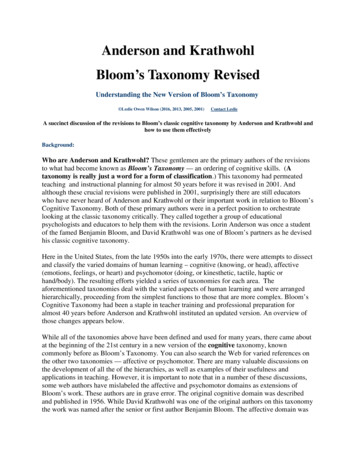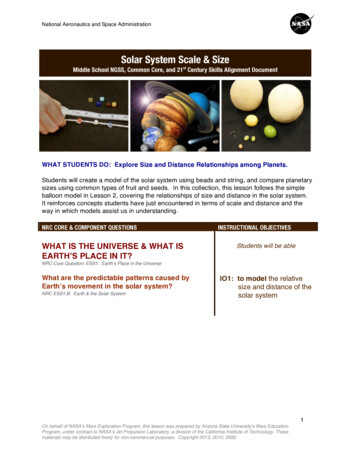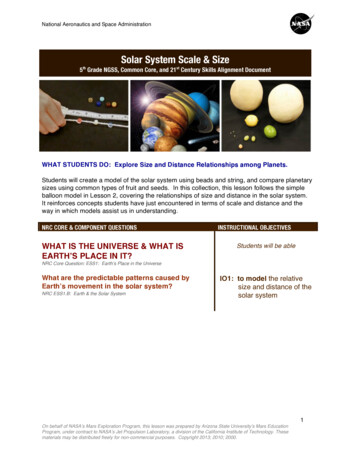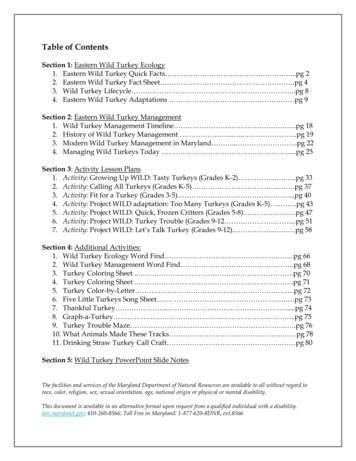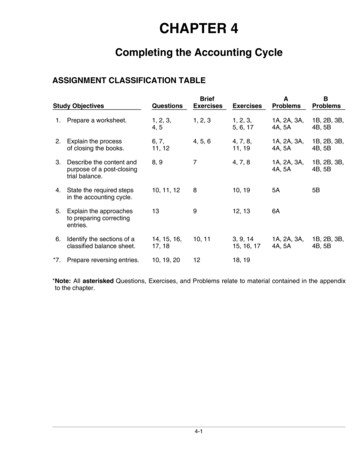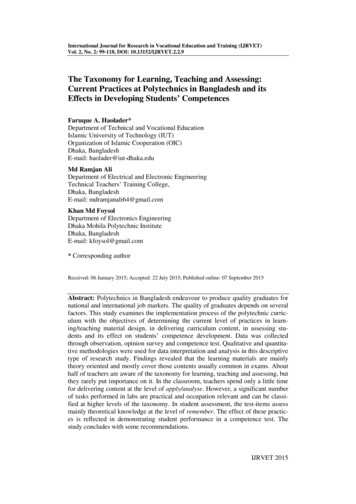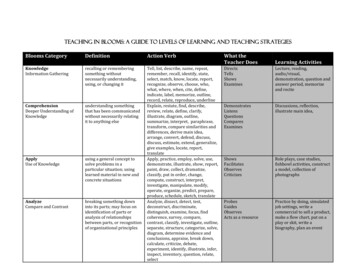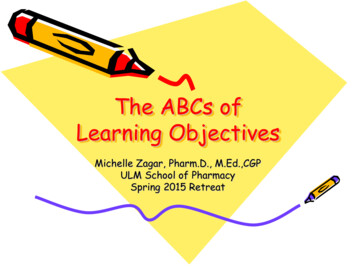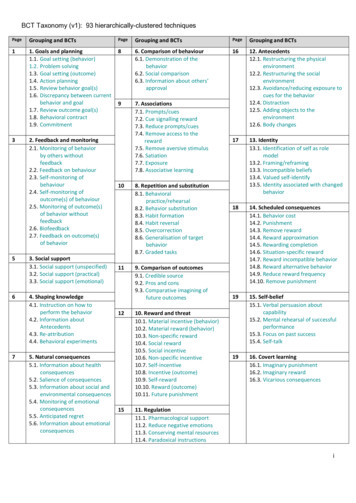
Transcription
BCT Taxonomy (v1): 93 hierarchically-clustered techniquesPageGrouping and BCTsPageGrouping and BCTsPageGrouping and BCTs11. Goals and planning1.1. Goal setting (behavior)1.2. Problem solving1.3. Goal setting (outcome)1.4. Action planning1.5. Review behavior goal(s)1.6. Discrepancy between currentbehavior and goal1.7. Review outcome goal(s)1.8. Behavioral contract1.9. Commitment86. Comparison of behaviour6.1. Demonstration of thebehavior6.2. Social comparison6.3. Information about others’approval1697. Associations7.1. Prompts/cues7.2. Cue signalling reward7.3. Reduce prompts/cues7.4. Remove access to thereward7.5. Remove aversive stimulus7.6. Satiation7.7. Exposure7.8. Associative learning12. Antecedents12.1. Restructuring the physicalenvironment12.2. Restructuring the socialenvironment12.3. Avoidance/reducing exposure tocues for the behavior12.4. Distraction12.5. Adding objects to theenvironment12.6. Body changes1713. Identity13.1. Identification of self as rolemodel13.2. Framing/reframing13.3. Incompatible beliefs13.4. Valued self-identify13.5. Identity associated with changedbehavior1814. Scheduled consequences14.1. Behavior cost14.2. Punishment14.3. Remove reward14.4. Reward approximation14.5. Rewarding completion14.6. Situation-specific reward14.7. Reward incompatible behavior14.8. Reward alternative behavior14.9. Reduce reward frequency14.10. Remove punishment1915. Self-belief15.1. Verbal persuasion aboutcapability15.2. Mental rehearsal of successfulperformance15.3. Focus on past success15.4. Self-talk1916. Covert learning16.1. Imaginary punishment16.2. Imaginary reward16.3. Vicarious consequences35672. Feedback and monitoring2.1. Monitoring of behaviorby others withoutfeedback2.2. Feedback on behaviour2.3. Self-monitoring ofbehaviour2.4. Self-monitoring ofoutcome(s) of behaviour2.5. Monitoring of outcome(s)of behavior withoutfeedback2.6. Biofeedback2.7. Feedback on outcome(s)of behavior3. Social support3.1. Social support (unspecified)3.2. Social support (practical)3.3. Social support (emotional)4. Shaping knowledge4.1. Instruction on how toperform the behavior4.2. Information aboutAntecedents4.3. Re-attribution4.4. Behavioral experiments5. Natural consequences5.1. Information about healthconsequences5.2. Salience of consequences5.3. Information about social andenvironmental consequences5.4. Monitoring of emotionalconsequences5.5. Anticipated regret5.6. Information about emotionalconsequences101112158. Repetition and substitution8.1. Behavioralpractice/rehearsal8.2. Behavior substitution8.3. Habit formation8.4. Habit reversal8.5. Overcorrection8.6. Generalisation of targetbehavior8.7. Graded tasks9. Comparison of outcomes9.1. Credible source9.2. Pros and cons9.3. Comparative imagining offuture outcomes10. Reward and threat10.1. Material incentive (behavior)10.2. Material reward (behavior)10.3. Non-specific reward10.4. Social reward10.5. Social incentive10.6. Non-specific incentive10.7. Self-incentive10.8. Incentive (outcome)10.9. Self-reward10.10. Reward (outcome)10.11. Future punishment11. Regulation11.1. Pharmacological support11.2. Reduce negative emotions11.3. Conserving mental resources11.4. Paradoxical instructionsi
BCT Taxonomy (v1): 93 hierarchically-clustered techniquesNote for UsersThe definitions of Behavior Change Techniques (BCTs):i)ii)iii)iv)contain verbs (e.g., provide, advise, arrange, prompt) that refer to the action(s)taken by the person/s delivering the technique. BCTs can be delivered by an ‘interventionist’ or selfdeliveredcontain the term “behavior” referring to a single action or sequence of actions that includes theperformance of wanted behavior(s) and/or inhibition (non-performance) of unwanted behavior(s)note alternative or additional coding where relevantnote the technical terms associated with particular theoretical frameworks where relevant (e.g.‘including implementation intentions)No.Label1. Goals and planning1.1Goal setting (behavior)1.2Problem solvingDefinitionExamplesSet or agree on a goal defined in terms ofthe behavior to be achievedNote: only code goal-setting if there issufficient evidence that goal set as part ofintervention; if goal unspecified or abehavioral outcome, code 1.3, Goalsetting (outcome); if the goal defines aspecific context, frequency, duration orintensity for the behavior, also code 1.4,Action planningAgree on a daily walking goal(e.g. 3 miles) with the person andreach agreement about the goalAnalyse , or prompt the person to analyse,factors influencing the behavior andgenerate or select strategies that includeovercoming barriers and/or increasingfacilitators (includes ‘Relapse Prevention’and ‘Coping Planning’)Note: barrier identification withoutsolutions is not sufficient. If the BCT doesnot include analysing the behavioralproblem, consider 12.3,Avoidance/changing exposure to cues forthe behavior, 12.1, Restructuring thephysical environment, 12.2, Restructuringthe social environment, or 11.2, Reducenegative emotionsIdentify specific triggers (e.g.being in a pub, feeling anxious)that generate theurge/want/need to drink anddevelop strategies for avoidingenvironmental triggers or formanaging negative emotions,such as anxiety, that motivatedrinkingSet the goal of eating 5 pieces offruit per day as specified in publichealth guidelinesPrompt the patient to identifybarriers preventing them fromstarting a new exercise regimee.g., lack of motivation, anddiscuss ways in which they couldhelp overcome them e.g., goingto the gym with a buddyBack to index page1
1.3Goal setting (outcome)Set or agree on a goal defined in terms ofa positive outcome of wanted behaviorNote: only code guidelines if set as a goalin an intervention context; if goal is abehavior, code 1.1, Goal setting(behavior); if goal unspecified code 1.3,Goal setting (outcome)Set a weight loss goal (e.g. 0.5kilogram over one week) as anoutcome of changed eatingpatterns1.4Action planningPrompt detailed planning of performanceof the behavior (must include at least oneof context, frequency, duration andintensity). Context may be environmental(physical or social) or internal (physical,emotional or cognitive) (includes‘Implementation Intentions’)Note: evidence of action planning does notnecessarily imply goal setting, only codelatter if sufficient evidenceEncourage a plan to carrycondoms when going out sociallyat weekendsPrompt planning theperformance of a particularphysical activity (e.g. running) ata particular time (e.g. beforework) on certain days of theweek1.5Review behavior goal(s)Review behavior goal(s) jointly with theperson and consider modifying goal(s) orbehavior change strategy in light ofachievement. This may lead to re-settingthe same goal, a small change in that goalor setting a new goal instead of (or inaddition to) the first, or no changeNote: if goal specified in terms ofbehavior, code 1.5, Review behaviorgoal(s), if goal unspecified, code 1.7,Review outcome goal(s); if discrepancycreated consider also 1.6, Discrepancybetween current behavior and goalExamine how well a person’sperformance corresponds toagreed goals e.g. whether theyconsumed less than one unit ofalcohol per day, and considermodifying future behavioral goalsaccordingly e.g. by increasing ordecreasing alcohol target orchanging type of alcoholconsumed1.6Discrepancy betweencurrent behavior andgoalDraw attention to discrepancies betweena person’s current behavior (in terms ofthe form, frequency, duration, or intensityof that behavior) and the person’spreviously set outcome goals, behavioralgoals or action plans (goes beyond selfmonitoring of behavior)Note: if discomfort is created only code13.3, Incompatible beliefs and not 1.6,Discrepancy between current behaviorand goal; if goals are modified, also code1.5, Review behavior goal(s) and/or 1.7,Review outcome goal(s); if feedback isprovided, also code 2.2, Feedback onbehaviourPoint out that the recordedexercise fell short of the goal setBack to index page2
1.7Review outcome goal(s)Review outcome goal(s) jointly with theperson and consider modifying goal(s) inlight of achievement. This may lead to resetting the same goal, a small change inthat goal or setting a new goal instead of,or in addition to the firstNote: if goal specified in terms ofbehavior, code 1.5, Review behaviorgoal(s), if goal unspecified, code 1.7,Review outcome goal(s); if discrepancycreated consider also 1.6, Discrepancybetween current behavior and goalExamine how much weight hasbeen lost and consider modifyingoutcome goal(s) accordingly e.g.,by increasing or decreasingsubsequent weight loss targets1.8Behavioral contractCreate a written specification of thebehavior to be performed, agreed on bythe person, and witnessed by anotherNote: also code 1.1, Goal setting(behavior)Sign a contract with the persone.g. specifying that they will notdrink alcohol for one week1.9CommitmentAsk the person to affirm or reaffirmstatements indicating commitment tochange the behaviorNote: if defined in terms of the behavior tobe achieved also code 1.1, Goal setting(behavior)Ask the person to use an “I will”statement to affirm or reaffirm astrong commitment (i.e. usingthe words “strongly”,“committed” or “high priority”)to start, continue or restart theattempt to take medication asprescribedObserve or record behavior with theperson’s knowledge as part of a behaviorchange strategyNote: if monitoring is part of a datacollection procedure rather than astrategy aimed at changing behavior, donot code; if feedback given, code only 2.2,Feedback on behavior, and not 2.1,Monitoring of behavior by others withoutfeedback; if monitoring outcome(s) code2.5, Monitoring outcome(s) of behaviorby others without feedback; if selfmonitoring behavior, code 2.3, Selfmonitoring of behaviourWatch hand washing behaviorsamong health care staff andmake notes on context,frequency and technique used2. Feedback and monitoring2.1Monitoring of behaviorby others withoutfeedbackBack to index page3
2.2Feedback on behaviorMonitor and provide informative orevaluative feedback on performance ofthe behavior (e.g. form, frequency,duration, intensity)Note: if Biofeedback, code only 2.6,Biofeedback and not 2.2, Feedback onbehavior; if feedback is on outcome(s) ofbehavior, code 2.7, Feedback onoutcome(s) of behavior; if there is no clearevidence that feedback was given, code2.1, Monitoring of behavior by otherswithout feedback; if feedback onbehaviour is evaluative e.g. praise, alsocode 10.4, Social rewardInform the person of how manysteps they walked each day (asrecorded on a pedometer) orhow many calories they ate eachday (based on a foodconsumption questionnaire).2.3Self-monitoring ofbehaviorEstablish a method for the person tomonitor and record their behavior(s) aspart of a behavior change strategyNote: if monitoring is part of a datacollection procedure rather than astrategy aimed at changing behavior, donot code; if monitoring of outcome ofbehavior, code 2.4, Self-monitoring ofoutcome(s) of behavior; if monitoring isby someone else (without feedback), code2.1, Monitoring of behavior by otherswithout feedbackAsk the person to record daily, ina diary, whether they havebrushed their teeth for at leasttwo minutes before going to bedEstablish a method for the person tomonitor and record the outcome(s) oftheir behavior as part of a behaviorchange strategyNote: if monitoring is part of a datacollection procedure rather than astrategy aimed at changing behavior, donot code ; if monitoring behavior, code2.3, Self-monitoring of behavior; ifmonitoring is by someone else (withoutfeedback), code 2.5, Monitoringoutcome(s) of behavior by others withoutfeedbackAsk the person to weighthemselves at the end of eachday, over a two week period, andrecord their daily weight on agraph to increase exercisebehaviors2.4Self-monitoring ofoutcome(s) of behaviorGive patient a pedometer and aform for recording daily totalnumber of stepsBack to index page4
2.5Monitoring outcome(s)of behavior by otherswithout feedbackObserve or record outcomes of behaviorRecord blood pressure, bloodwith the person’s knowledge as part of aglucose, weight loss, or physicalbehavior change strategyfitnessNote: if monitoring is part of a datacollection procedure rather than astrategy aimed at changing behavior, donot code; if feedback given, code only 2.7,Feedback on outcome(s) of behavior; ifmonitoring behavior code 2.1, Monitoringof behavior by others without feedback; ifself-monitoring outcome(s), code 2.4, Selfmonitoring of outcome(s) of behavior2.6BiofeedbackProvide feedback about the body (e.g.physiological or biochemical state) usingan external monitoring device as part of abehavior change strategyNote: if Biofeedback, code only 2.6,Biofeedback and not 2.2, Feedback onbehavior or 2.7, Feedback on outcome(s)of behaviourInform the person of their bloodpressure reading to improveadoption of health behaviors2.7Feedback on outcome(s)of behaviorMonitor and provide feedback on theoutcome of performance of the behaviorNote: if Biofeedback, code only 2.6,Biofeedback and not 2.7, Feedback onoutcome(s) of behavior; if feedback is onbehavior code 2.2, Feedback on behavior;if there is no clear evidence that feedbackwas given code 2.5, Monitoringoutcome(s) of behavior by others withoutfeedback; if feedback on behaviour isevaluative e.g. praise, also code 10.4,Social rewardInform the person of how muchweight they have lost followingthe implementation of a newexercise regimeAdvise on, arrange or provide socialsupport (e.g. from friends, relatives,colleagues,’ buddies’ or staff) or noncontingent praise or reward forperformance of the behavior. It includesencouragement and counselling, but onlywhen it is directed at the behaviorNote: attending a group class and/ormention of ‘follow-up’ does not necessarilyapply this BCT, support must be explicitlymentioned; if practical, code 3.2, Socialsupport (practical); if emotional, code 3.3,Social support (emotional) (includes‘Motivational interviewing’ and‘Cognitive Behavioral Therapy’)Advise the person to call a‘buddy’ when they experience anurge to smoke3. Social support3.1Social support(unspecified)Arrange for a housemate toencourage continuation with thebehavior change programmeGive information about a selfhelp group that offers support forthe behaviourBack to index page5
3.2Social support (practical)Advise on, arrange, or provide practicalhelp (e.g. from friends, relatives,colleagues, ‘buddies’ or staff) forperformance of the behaviorNote: if emotional, code 3.3, Socialsupport (emotional); if general orunspecified, code 3.1, Social support(unspecified) If only restructuring thephysical environment or adding objects tothe environment, code 12.1, Restructuringthe physical environment or 12.5, Addingobjects to the environment; attending agroup or class and/or mention of ‘followup’ does not necessarily apply this BCT,support must be explicitly mentioned.Ask the partner of the patient toput their tablet on the breakfasttray so that the patientremembers to take it3.3Social support(emotional)Advise on, arrange, or provide emotionalsocial support (e.g. from friends, relatives,colleagues, ‘buddies’ or staff) forperformance of the behaviorNote: if practical, code 3.2, Social support(practical); if unspecified, code 3.1, Socialsupport (unspecified)Ask the patient to take a partneror friend with them to theircolonoscopy appointmentAdvise or agree on how to perform thebehavior (includes ‘Skills training’)Note: when the person attends classessuch as exercise or cookery, code 4.1,Instruction on how to perform thebehavior, 8.1, Behavioralpractice/rehearsal and 6.1,Demonstration of the behaviorAdvise the person how to put acondom on a model of a peniscorrectly4. Shaping knowledge4.1Instruction on how toperform a behavior4.2Information aboutantecedentsProvide information about antecedents(e.g. social and environmental situationsand events, emotions, cognitions) thatreliably predict performance of thebehaviourAdvise to keep a record ofsnacking and of situations orevents occurring prior to snacking4.3Re-attributionElicit perceived causes of behavior andsuggest alternative explanations (e.g.external or internal and stable or unstable)If the person attributes theirover-eating to the frequentpresence of delicious food,suggest that the ‘real’ cause maybe the person’s inattention tobodily signals of hunger andsatietyBack to index page6
4.4Behavioral experiments5. Natural consequences5.1Information abouthealth consequencesAdvise on how to identify and testhypotheses about the behavior, its causesand consequences, by collecting andinterpreting dataAsk a family physician to giveevidence-based advice ratherthan prescribe antibiotics and tonote whether the patients aregrateful or annoyedProvide information (e.g. written, verbal,visual) about health consequences ofperforming the behaviorNote: consequences can be for any target,not just the recipient(s) of theintervention; emphasising importance ofconsequences is not sufficient; ifinformation about emotionalconsequences, code 5.6, Informationabout emotional consequences; if aboutsocial, environmental or unspecifiedconsequences code 5.3, Informationabout social and environmentalconsequencesExplain that not finishing a courseof antibiotics can increasesusceptibility to future infectionPresent the likelihood ofcontracting a sexuallytransmitted infection followingunprotected sexual behavior5.2Salience ofconsequencesUse methods specifically designed toemphasise the consequences ofperforming the behaviour with the aim ofmaking them more memorable (goesbeyond informing about consequences)Note: if information about consequences,also code 5.1, Information about healthconsequences, 5.6, Information aboutemotional consequences or 5.3,Information about social andenvironmental consequencesProduce cigarette packetsshowing pictures of healthconsequences e.g. diseasedlungs, to highlight the dangers ofcontinuing to smoke5.3Information about socialand environmentalconsequencesProvide information (e.g. written, verbal,visual) about social and environmentalconsequences of performing the behaviorNote: consequences can be for any target,not just the recipient(s) of theintervention; if information about healthor consequences, code 5.1, Informationabout health consequences; if aboutemotional consequences, code 5.6,Information about emotionalconsequences; if unspecified, code 5.3,Information about social andenvironmental consequencesTell family physician aboutfinancial remuneration forconducting health screeningPrompt assessment of feelings afterattempts at performing the behaviorAgree that the person will recordhow they feel after taking theirdaily walk5.4Monitoring of emotionalconsequencesInform a smoker that themajority of people disapprove ofsmoking in public placesBack to index page7
5.5Anticipated regretInduce or raise awareness of expectationsof future regret about performance of theunwanted behaviorNote: not including 5.6, Informationabout emotional consequences; ifsuggests adoption of a perspective or newperspective in order to change cognitionsalso code 13.2, Framing/reframingAsk the person to assess thedegree of regret they will feel ifthey do not quit smoking5.6Information aboutemotional consequencesProvide information (e.g. written, verbal,visual) about emotional consequences ofperforming the behaviorNote: consequences can be related toemotional health disorders (e.g.depression, anxiety) and/or states of mind(e.g. low mood, stress); not including 5.5,Anticipated regret; consequences can befor any target, not just the recipient(s) ofthe intervention; if information abouthealth consequences code 5.1,Information about health consequences;if about social, environmental orunspecified code 5.3, Information aboutsocial and environmental consequencesExplain that quitting smokingincreases happiness and lifesatisfactionProvide an observable sample of theperformance of the behaviour, directly inperson or indirectly e.g. via film, pictures,for the person to aspire to or imitate(includes ‘Modelling’). Note: if advised topractice, also code, 8.1, Behaviouralpractice and rehearsal; If provided withinstructions on how to perform, also code4.1, Instruction on how to perform thebehaviourDemonstrate to nurses how toraise the issue of excessivedrinking with patients via a roleplay exercise6. Comparison of behaviour6.1Demonstration of thebehavior6.2Social comparisonDraw attention to others’ performance toallow comparison with the person’s ownperformance Note: being in a groupsetting does not necessarily mean thatsocial comparison is actually taking placeShow the doctor the proportionof patients who were prescribedantibiotics for a common cold byother doctors and compare withtheir own data6.3Information aboutothers’ approvalProvide information about what otherpeople think about the behavior. Theinformation clarifies whether others willlike, approve or disapprove of what theperson is doing or will doTell the staff at the hospital wardthat staff at all other wardsapprove of washing their handsaccording to the guidelinesBack to index page8
7. Associations7.1Prompts/cuesIntroduce or define environmental orsocial stimulus with the purpose ofprompting or cueing the behavior. Theprompt or cue would normally occur atthe time or place of performanceNote: when a stimulus is linked to aspecific action in an if-then plan includingone or more of frequency, duration orintensity also code 1.4, Action planning.Put a sticker on the bathroommirror to remind people to brushtheir teeth7.2Cue signalling rewardIdentify an environmental stimulus thatreliably predicts that reward will followthe behavior (includes ‘Discriminativecue’)Advise that a fee will be paid todentists for a particular dentaltreatment of 6-8 year old, but notolder, children to encouragedelivery of that treatment (the 68 year old children are theenvironmental stimulus)7.3Reduce prompts/cuesWithdraw gradually prompts to performthe behavior (includes ‘Fading’)Reduce gradually the number ofreminders used to takemedication7.4Remove access to therewardAdvise or arrange for the person to beseparated from situations in whichunwanted behavior can be rewarded inorder to reduce the behavior (includes‘Time out’)Arrange for cupboard containinghigh calorie snacks to be lockedfor a specified period to reducethe consumption of sugary foodsin between meals7.5Remove aversivestimulusAdvise or arrange for the removal of anaversive stimulus to facilitate behaviorchange (includes ‘Escape learning’)Arrange for a gym-buddy to stopnagging the person to do moreexercise in order to increase thedesired exercise behaviour7.6SatiationAdvise or arrange repeated exposure to astimulus that reduces or extinguishes adrive for the unwanted behaviorArrange for the person to eatlarge quantities of chocolate, inorder to reduce the person’sappetite for sweet foods7.7ExposureProvide systematic confrontation with afeared stimulus to reduce the response toa later encounterAgree a schedule by which theperson who is frightened ofsurgery will visit the hospitalwhere they are scheduled tohave surgeryBack to index page9
7.8Associative learning8. Repetition and substitution8.1Behavioral practice/rehearsalPresent a neutral stimulus jointly with astimulus that already elicits the behaviorrepeatedly until the neutral stimuluselicits that behavior (includes‘Classical/Pavlovian Conditioning’)Note: when a BCT involves reward orpunishment, code one or more of: 10.2,Material reward (behavior); 10.3, Nonspecific reward; 10.4, Social reward, 10.9,Self-reward; 10.10, Reward (outcome)Present repeatedly fatty foodswith a disliked sauce todiscourage the consumption offatty foodsPrompt practice or rehearsal of theperformance of the behavior one or moretimes in a context or at a time when theperformance may not be necessary, inorder to increase habit and skillNote: if aiming to associate performancewith the context, also code 8.3, HabitformationPrompt asthma patients topractice measuring their peakflow in the nurse’s consultingroom8.2Behavior substitutionPrompt substitution of the unwantedbehavior with a wanted or neutralbehaviorNote: if this occurs regularly, also code8.4, Habit reversalSuggest that the person goes fora walk rather than watchestelevision8.3Habit formationPrompt rehearsal and repetition of thebehavior in the same context repeatedlyso that the context elicits the behaviorNote: also code 8.1, Behavioralpractice/rehearsalPrompt patients to take theirstatin tablet before brushingtheir teeth every evening8.4Habit reversalPrompt rehearsal and repetition of analternative behavior to replace anunwanted habitual behaviorNote: also code 8.2, Behavior substitutionAsk the person to walk up stairsat work where they previouslyalways took the lift8.5OvercorrectionAsk to repeat the wanted behavior in anexaggerated way following an unwantedbehaviourAsk to eat only fruit andvegetables the day after a poordiet8.6Generalisation of atarget behaviorAdvise to perform the wanted behaviour,which is already performed in a particularsituation, in another situationAdvise to repeat toning exerciseslearned in the gym when at homeBack to index page10
8.7Graded tasks9. Comparison of outcomes9.1Credible sourceSet easy-to-perform tasks, making themincreasingly difficult, but achievable, untilbehavior is performedAsk the person to walk for 100yards a day for the first week,then half a mile a day after theyhave successfully achieved 100yards, then two miles a day afterthey have successfully achievedone milePresent verbal or visual communicationfrom a credible source in favour of oragainst the behaviorNote: code this BCT if source generallyagreed on as credible e.g., healthprofessionals, celebrities or words used toindicate expertise or leader in field and ifthe communication has the aim ofpersuading; if information about healthconsequences, also code 5.1, Informationabout health consequences, if aboutemotional consequences, also code 5.6,Information about emotionalconsequences; if about social,environmental or unspecifiedconsequences also code 5.3, Informationabout social and environmentalconsequencesPresent a speech given by a highstatus professional to emphasisethe importance of not exposingpatients to unnecessary radiationby ordering x-rays for back pain9.2Pros and consAdvise the person to identify and comparereasons for wanting (pros) and notwanting to (cons) change the behavior(includes ‘Decisional balance’)Note: if providing information abouthealth consequences, also code 5.1,Information about health consequences;if providing information about emotionalconsequences, also code 5.6, Informationabout emotional consequences; ifproviding information about social,environmental or unspecifiedconsequences also code 5.3, Informationabout social and environmentalconsequencesAdvise the person to list andcompare the advantages anddisadvantages of prescribingantibiotics for upper respiratorytract infections9.3Comparative imaginingof future outcomesPrompt or advise the imagining andcomparing of future outcomes of changedversus unchanged behaviourPrompt the person to imagineand compare likely or possibleoutcomes following attendingversus not attending a screeningappointmentBack to index page11
10. Reward and threat10.1 Material incentive(behavior)Inform that money, vouchers or othervalued objects will be delivered if and onlyif there has been effort and/or progress inperforming the behavior (includes‘Positive reinforcement’)Note: if incentive is social, code 10.5,Social incentive if unspecified code 10.6,Non-specific incentive, and not 10.1,Material incentive (behavior); if incentiveis for outcome, code 10.8, Incentive(outcome). If reward is delivered also codeone of: 10.2, Material reward (behavior);10.3, Non-specific reward; 10.4, Socialreward, 10.9, Self-reward; 10.10, Reward(outcome)Inform that a financial paymentwill be made each month inpregnancy that the woman hasnot smoked10.2Material reward(behavior)Arrange for the delivery of money,vouchers or other valued objects if andonly if there has been effort and/orprogress in performing the behavior(includes ‘Positive reinforcement’)Note: If reward is social, code 10.4, Socialreward, if unspecified code 10.3, Nonspecific reward, and not 10.1, Materialreward (behavior); if reward is foroutcome, code 10.10, Reward (outcome).If informed of reward in advance ofrewarded behaviour, also code one of:10.1, Material incentive (behaviour);10.5, Social incentive; 10.6, Non-specificincentive; 10.7, Self-incentive; 10.8,Incentive (outcome)Arrange for the person to receivemoney that would have beenspent on cigarettes if and only ifthe smoker has not smoked forone month10.3Non-specific rewardArrange delivery of a reward if and only ifthere has been effort and/or progress inperforming the behavior (includes‘Positive reinforcement’)Note: if reward is material, code 10.2,Material reward (behavior), if social, code10.4, Social reward, and not 10.3, Nonspecific reward; if reward is for outcomecode 10.10, Reward (outcome). Ifinformed of reward in advance ofrewarded behaviour, also code one of:10.1, Material incentive (behaviour);10.5, Social incentive; 10.6, Non-specificincentive; 10.7, Self-incentive; 10.8,Incentive (outcome)Identify something (e.g. anactivity such as a visit to thecinema) that the person valuesand arrange for this to bedelivered if and only if theyattend for health screeningBack to index page12
10.4Social rewardArrange verbal or non-verbal reward ifand only if there has been effort and/orprogress in performing the behavior(includes ‘Positive reinforcement’)Note: if reward is material, code 10.2,Material reward (behavior), if unspecifiedcode 10.3, Non-specific reward, and not10.4, Social reward; if reward is foroutcome code 10.10, Reward (outcome).If informed of reward in advance ofrewarded behaviour, also code one of:10.1, Material incentive (behaviour);10.5, Social incentive; 10.6, Non-specificincentive; 10.7, Self-incentive; 10.8,Incentive
BCT Taxonomy (v1): 93 hierarchically-clustered techniques Note for Users The definitions of Behavior Change Techniques (BCTs): i) contain verbs (e.g., provide, advise, arrange, prompt) that refer to the action(s) taken by the person/s delivering the technique. BCTs c

